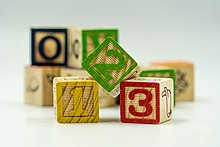
Back عد (رياضيات) Arabic Pagbilang BCL गिनती Bihari Comptar Catalan Ihap CEB ژماردن CKB Počítání Czech Шут CV Zählen German Nintaban DTP

Counting is the process of determining the number of elements of a finite set of objects; that is, determining the size of a set. The traditional way of counting consists of continually increasing a (mental or spoken) counter by a unit for every element of the set, in some order, while marking (or displacing) those elements to avoid visiting the same element more than once, until no unmarked elements are left; if the counter was set to one after the first object, the value after visiting the final object gives the desired number of elements. The related term enumeration refers to uniquely identifying the elements of a finite (combinatorial) set or infinite set by assigning a number to each element.
Counting sometimes involves numbers other than one; for example, when counting money, counting out change, "counting by twos" (2, 4, 6, 8, 10, 12, ...), or "counting by fives" (5, 10, 15, 20, 25, ...).
There is archaeological evidence suggesting that humans have been counting for at least 50,000 years.[1] Counting was primarily used by ancient cultures to keep track of social and economic data such as the number of group members, prey animals, property, or debts (that is, accountancy). Notched bones were also found in the Border Caves in South Africa, which may suggest that the concept of counting was known to humans as far back as 44,000 BCE.[2] The development of counting led to the development of mathematical notation, numeral systems, and writing.
- ^ An Introduction to the History of Mathematics (6th Edition) by Howard Eves (1990) p.9
- ^ "Early Human Counting Tools". Math Timeline. Retrieved 2018-04-26.